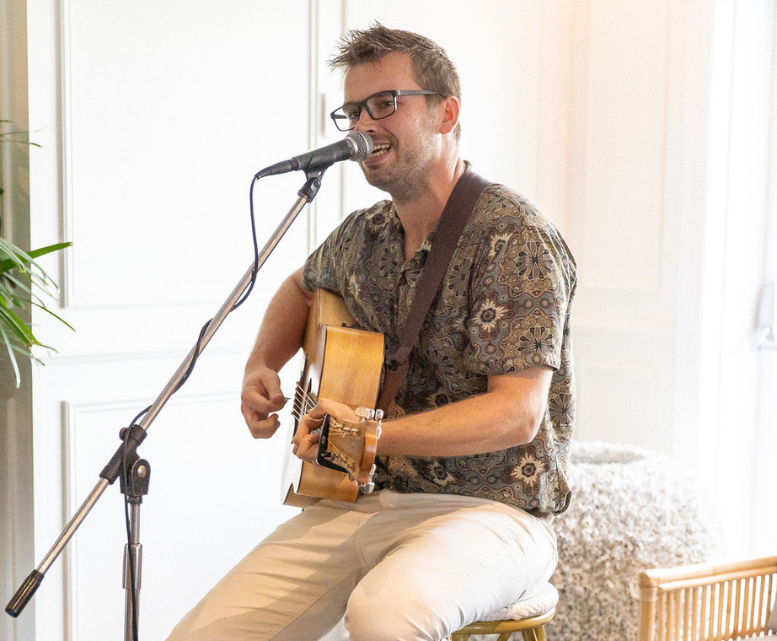As a wedding musician, you play a vital role in creating an immersive, unforgettable
experience for the wedding couple and their special guests. By providing a soundtrack of
joy and celebration on their special day, you are helping them create the memories that
they will cherish for the rest of their lives. The wedding couple, their families and invited
guests, come together from all cultural backgrounds to celebrate the union of two people
in love.
Being a musician isn’t just about arriving with a one-size-fits-all set list. It is essential to
recognise and honour the nuances of the various cultural traditions that each couple
brings with them.
Cultural Sensitivity in Wedding Music
It is crucial for wedding musicians to take cultural sensitivity into account when creating
the perfect musical atmosphere for all weddings. Music can be an expression of shared
values and beliefs and there is a delicate balance required to ensure the blend feels right –
first and foremost for the wedding couple, because it is a day all about them.
Weddings are celebrated in many different ways – from religious ceremonies to more
traditional ones, small ones to big ones and simple ones to more extravagant ones.
Cultural weddings celebrate diversity in all its intersectionalities and goes far beyond
ethnic traditions and musical activities.
With many cultures blending together – no two weddings are the same. The same goes
with music. You can simply see the many influences of music all around the world in
today’s chart topping hits.
Collaborating with Couples for Culturally Relevant Music Choices
When meeting with couples to plan their wedding music, it is important to be open
minded and be prepared to think outside the box. Encourage them to see that music is a
journey, as one connected thread – accompanying them from processional to recessional
in their ceremony, continuing seamlessly to their reception until the end of the day/night.
Find as many different ways to discover how they connect to music. Couples should
each consider music that resonates with them, as individuals, that represents each of
their self-expressions through their own cultures and backgrounds. Next, find out where
their shared love for music lies. Collate this together and use your creativity to suggest a
variety of ways to blend their needs into a unique musical experience – one that is not just
a perfect renditions of a chart topping hits, exactly as it is written.
Key Features of Various Cultural Wedding Music
Below is a list of Cultural Weddings most common in Australia
Asian Wedding Music
Indian
Indian wedding music features rich and musical accompaniment with instruments like
the sitar, tabla, and harmonium. They encompass various musical genres, including
traditional classical music, folk music, contemporary Bollywood songs, and fusion
blends. Use of percussive elements such as cymbals, drums, bells or gongs to create an
atmosphere of celebration, with songs that encourage audience participation through
singing and clapping along.
The music often carries emotional weight, creating a sense of joy, nostalgia, and
connection. From the vibrant sangeet ceremony to the spirited baraat procession, and
from region-specific folk music to emotional religious chants, this music infuses each
celebration with joy, nostalgia, and a sense of togetherness.
Chinese
Embracing traditional instruments like the guzheng and erhu, Chinese wedding music
enriches rituals such as the tea ceremony and dragon dances, while also accommodating
modern influences with popular songs.
The music often seeks to embody the principles of harmony and balance, reflecting the
core values of Chinese culture and Chinese people. Many Chinese wedding songs are
chosen for their auspicious meanings, with lyrics often conveying blessings, good
fortune, and happiness for the newlyweds.
Japanese
Rooted in tradition and elegance, Japanese wedding music often features instruments
like the koto and shakuhachi, creating a serene and symbolic ambiance for Shinto rituals
such as the san-san-kudo ceremony and sakaki tree offering. The music is carefully
selected to maintain a harmonious flow of events throughout the ceremony, contributing
to the overall sense of unity and meaning.
In some regions, the traditional folk songs of Japanese people are integrated into
weddings, connecting the celebration to local heritage. Certain musical pieces are
chosen for cultural symbolism, often representing purity, longevity, and prosperity.
African and Middle Eastern Wedding Music
African
The music often draws from traditional rhythms, as well as the sounds of popular genres
like Afrobeat, Highlife, Reggae, and Hip-hop. African wedding music is known for its
intricate and lively rhythms, often created using a variety of traditional percussion
instruments like drums, djembes, talking drums, and kalimbas. Vocal performances are a
central element, with rich harmonies and call-and-response patterns that engage
participants and evoke a sense of communal celebration.
Music is used to invoke blessings from ancestors or spirits, creating a spiritual
connection and inviting positive energies into the couple’s union.
Middle Eastern
Middle Eastern wedding music features instruments like the oud, darbuka, and zurna to
create stirring melodies that are blended with passionate vocals. The music is often
used to invoke joy and celebration, while also conveying spiritual messages of love, unity
and renewal. The lyrics often focus on themes of joyousness, prosperity, beauty, wisdom
and faithfulness – all sentiments that are essential to a successful union.
In modern Middle Eastern weddings, there’s a blend of traditional and modern elements,
with popular Arabic pop songs or international hits incorporated into the playlist.
European and Western Wedding Music
Italian
Italian wedding music is often characterised by an upbeat and passionate sound.
Traditional instruments like the mandolin, accordion, and tambourine provide a festive
atmosphere while popular pieces of opera or classical music add grandeur to the
occasion. Different regions of Italy have their own folk music traditions.
Serenades, where musicians perform love songs beneath a balcony or window, are a
romantic Italian tradition often seen in movies. These melodic declarations of love are
synonymous with Italian weddings. Italy’s operatic heritage plays a significant role, with
arias and vocal performances lending an emotional and dramatic touch to the ceremony.
Irish
Often characterised by lively and infectious tunes, traditional instruments such as the
fiddle, uilleann pipes, tin whistle, accordion, and bodhran are frequently used to provide a
festive atmosphere.
Ceili dances are an important part of Irish tradition; these energetic dance styles involve
all members of the wedding party in large circles or lines, creating a vibrant and joyful
atmosphere. Slow airs are often played during times of reflection or contemplation in the
ceremony, while jigs and reels can be performed to bring energy and celebration to the
proceedings.
American
American wedding music features a mix of musical styles, ranging from classical pieces
to popular songs, jazz, blues, and country. The focus is often on creating an upbeat party
atmosphere for the guests. Music choices are based on the couple’s personal tastes and
preferences; they might choose traditional favourites or more modern hits.
From background tunes during dinner to energetic hits for dancing, American
weddings infuse pop culture references, group dances, and party anthems to
create an inclusive and individualised experience.
A Short Guide to Fuse Cultural Music in a Contemporary World
Fusing cultural music does not only have to occur in a wedding of two different cultures.
In fact, a large majority of weddings in Australia feature traditional and contemporary
elements of the same culture.
- To seamlessly fuse traditional cultural music and contemporary music at a wedding, a
musician should: - Understand the couple’s background and preferences
Research both genres thoroughly - Select fitting songs
- Arrange and transition between them
- Collaborate with knowledgeable musicians
- Experiment with instruments and vocal styles
- Involve the wedding couple in the process
- Practice diligently
- Maintain a balance between the two genres,
- Respect tradition and family
- Engage with wedding guests, and ensure the performance is captured
effectively. - The goal is to create a harmonious and authentic blend that celebrates the couple’s
heritage while resonating with their everyday lives, as well as engaging their wedding
guests on their special day.
Case Studies: Successful Integration of Cultural Music in a Contemporary
World
Duke Music at the Wedding of Natalie and Sam (Woodhouse Wollombi)
When Natalie and Sam approached Event Entertainers to plan their wedding music, we
were thrilled to curate an unforgettable experience with them, to the sounds of Duke
Music. The rustic Australian landscape of The Woodhouse Wollombi was the perfect
backdrop for their wedding, as Natalie and Sam wanted to celebrate their wedding
following their Jewish Traditions but with a contemporary Australian twist.
The Duke Duo provided a pre-Ceremony music soundtrack, consisting of completely
modern hits with an acoustic vibe. Traditional Jewish music was introduced during their
religious ceremony as traditional vocalist, Isser performed traditional Jewish songs in
Hebrew, with modern guitar accompaniment by Duke. We felt that we achieved the fusion
of contemporary romantic music with traditional choices that Natalie and Sam intended
for their wedding day.
The reception started with a traditional Hora, with music performed by the Duke Band and
Isser leading the traditional vocals. It then quickly switched to modern favourites during
dinner service, with Duke providing light dinner music.
As dinner concluded, Natalie and Sam shared their first dance to Lover of the Light by
Mumford & Sons. The sound was upgraded in scale with, The Duke Quintet to provide a
full dance floor with crowd pleasing hits from The Red Hot Chilli Peppers, Kings of Leon,
Stevie Wonder and Queen!
This beautiful collaboration with a Traditional Jewish musician with the contemporary
Duke Music was an unforgettable one, and we hope that you can draw inspiration from
this when helping couples plan the soundtrack to their big day.
Read more here
Enjoy the Process!
In conclusion, remember to respect the couple’s heritage, consult with knowledgeable
musicians, experiment with instruments and vocal styles, and involve the wedding couple
in the process. Take into account their musical tastes and preferences while ensuring a
balanced and authentic blend of cultural music. Finally, enjoy the creative process of
creating memorable musical experiences for couples on their special day! We hope you
feel more empowered when working with couples to help them curate a wedding
experience that is musically blended in harmony.



Comments +